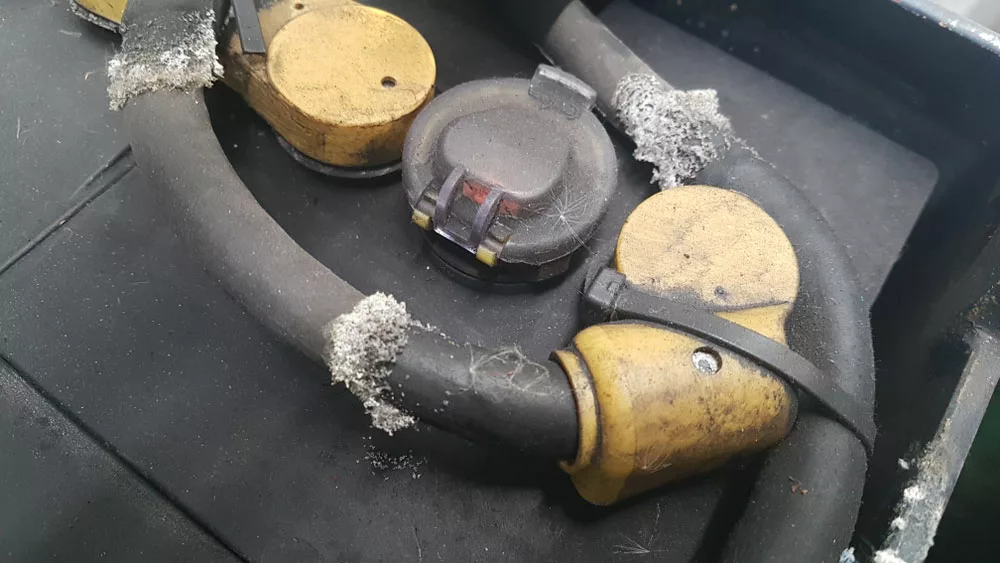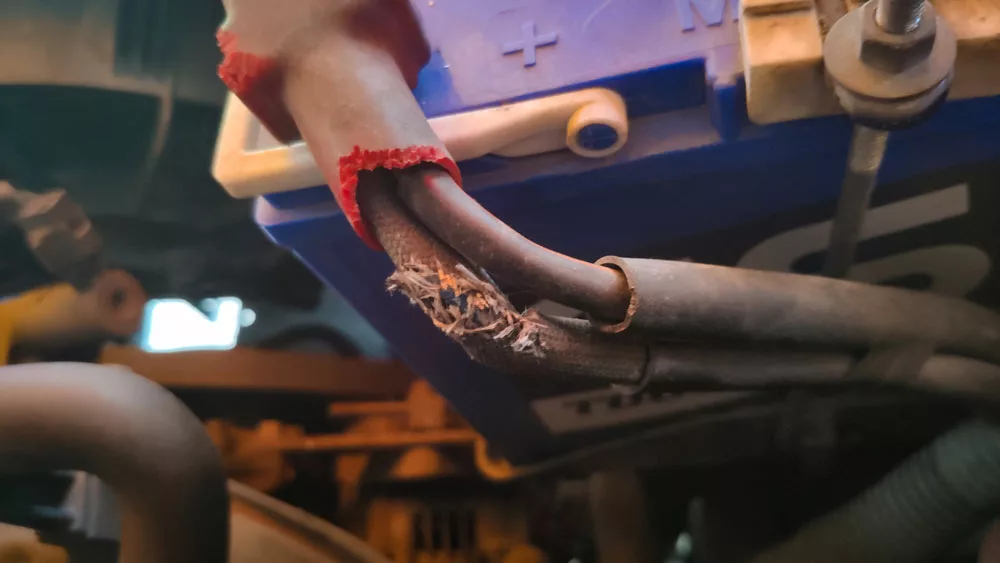The battery gets your vehicle started and should be in perfect condition. Your car battery cable corrosion is one of the issues that can keep the car from starting. The substances can make it hard for your battery to receive or deliver charge.
So, what causes corrosion, and how can you fix it? We answer these and several other questions in detail, but first, let’s learn what battery corrosion is.
Table of Contents
- What Is Battery Corrosion?
- What Causes Battery Cable Corrosion
- How to Clean Battery Cable Corrosion
- What’s the Difference Between Corrosion and Sulfation?
- How to Prevent Battery Corrosion
- Battery Cable Corrosion-FAQs
- Final Thought on Battery Cable Corrosion
What Is Battery Corrosion?
Corrosion is a product of a chemical reaction between liquid or hydrogen gas released from the inside of the battery and the metals of the terminals.
Battery corrosion mostly shows up as greenish-blue or white-tinged substances depending on the metal of your battery terminal.
For instance, if the corrosion is greenish blue, the battery terminal is copper (the substance is copper sulfate). Aluminum terminals will create an aluminum sulfate that is whitish or brown.

Whitish battery cable corrosion
What Causes Battery Cable Corrosion
Several factors can cause battery cable corrosion. However, they all originate from the same source – sulfuric acid and water inside your battery.
Hydrogen Gas
Your battery heats and cools naturally the same way your car does. As your car battery heats up and cools, it causes sulfuric acid to create and release hydrogen gas. The ventilated hydrogen gas mixes and reacts with other substances in the air around your battery terminal. The product of the reaction builds up over time to what you call corrosion.
Leaking Battery Fluid
An overfilled battery can cause leaking battery fluids. The fluid level in the battery should be above the plate. Never fill it too much, and never let it drop to the extent that it exposes the plates. If overfilled, the fluid may leak through the vents and corrode the battery terminals and cables.
The fluids may also escape through the cracks of a damaged battery casing and cause corrosion. Overcharging the battery may make the fluid inside expand and escape through the vents, causing corrosion.

Battery corrosion caused by leaking fluids
How to Clean Battery Cable Corrosion
Cleaning corroded battery cables is a task few people can do independently. But with our simple guide, any DIY enthusiast should be able to pull it through.
Before we get to cleaning, here are the materials you will need:
- Protective gloves and eye glasses
- Wrenches
- Baking soda or Battery cleaner
- Toothbrush
- Disposable rags
- Battery protector
- A bucket of water or Garden horse
Here is the step-by-step guide:
- Put on your protective eyeglasses and gloves
- Prepare your cleaning solution. Measure a cup of warm water into a container, add a tablespoon of your baking, and mix. If you are using commercial battery cleaners, there is no need for this step since you will only do the spray.
- Disconnect your battery cables using the wrench. It would be best if you started by removing the negative terminals. Removing the positive terminal first may result in a severe spark when the wrench touches the car body. This may damage your battery.
- Check if the corrosion in the cables and the terminals is extreme. If it is heavy to the extent of corrosion inside the battery cable, you may need to replace it. If the cable clamps and the terminal look healthy, move on to the step below.
- Apply baking soda + water liberally to the cable clamp and terminals. Using commercial cleaners, spray them on the battery terminal and cable clamps.
- Leave the solution to rest on the battery terminal and the cable clamp until it stops “fizzing.” Then rinse off the cable clamp, terminal, and battery.
- You can recoat the battery terminal again with baking soda or the commercial battery cleaning spray.
- Apply dielectric grease or terminal protector to the battery terminal. This will prevent corrosion that may occur between cleaning.
- You can now wipe your battery using a disposable rag. Be careful not to wipe off the terminal protector coating.

Corrosion inside the battery cable
What’s the Difference Between Corrosion and Sulfation?
Corrosion occurs when the acid reacts with the substances around the terminal’s metal, as described above. On the other hand, sulfation occurs when lead sulfate forms on the lead plate through crystallization.
Sulfation is a normal discharge process that you can reverse by charging the battery. Suppose you let your battery stay for too long without charging-a soft whitish or gray lead sulfate deposits on the negative terminal. On the terminal, the substance develops into a hard, stable crystal which hinders the flow of electric current.
You can easily remove corrosion as part of the regular maintenance routine. On the other hand, sulfation signifies more serious damage to the battery that requires replacement.
How to Prevent Battery Corrosion
This will depend on the type of battery that you are dealing with. Some are maintenance-free, and you don’t have to check the water level.
For those that require maintenance, you will have to carry out a routine inspection to ensure the water level is at the optimum level. This should be done in five to six months. Should the water level be low, ensure you refill it with distilled water to reach above the plates.
Your battery alternator should also be checked at least once a year as part of the maintenance. If you detect a problem, you should suggest a replacement.
Keeping your battery cable and terminals clean is another crucial maintenance step. You do this by applying a spray battery protector. The protector prevents moisture from getting to the battery terminal and seals the battery to block the acid from escaping.
For those who don’t want to deal with sprays, use BG Battery Protector Pads. You soak the pads in a corrosion-preventive chemical. Then place it on the terminals just before reattaching the battery cables. The pad protector can last the life of the battery. Meaning you will only consider replacing it when replacing your battery.
Battery Cable Corrosion-FAQs
Is Battery Corrosion Dangerous?
Battery corrosion is dangerous and can cause skin burns when touched. It is even riskier if you have a wound on your hand. Besides, when a battery corrodes, it releases mercury, lead, and toxin into the environment. The toxins can contaminate the air and water supply and cause health problems.
Does a Corroded Battery Need to be Replaced?
It will depend on the extent of the corrosion. If it is not too much, you can sufficiently clean it. Consider replacing your battery if the corrosion is extreme or caused by issues such as leaking or a bloated case. Other issues that indicate you need a new car battery include difficulty starting the vehicle, age, and persistent low battery fluid.
Final Thought on Battery Cable Corrosion
Battery cable corrosion occurs when the fluid inside or its component comes into contact with battery terminals. Therefore, prevention should aim at stopping the battery content from reaching the terminals.
However, you can easily fix battery cable corrosion through our simple step-by-step guide. If the corrosion is too extreme, you should consider replacing your battery.
